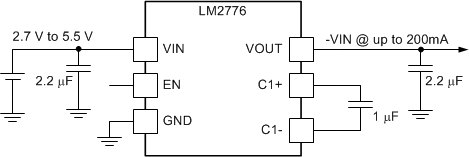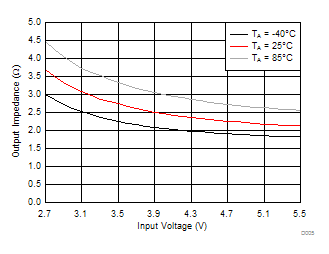ZHCSDP4B May 2015 – February 2017 LM2776
PRODUCTION DATA.
1 特性
- 输入电压:2.7V 至 5.5V
- 200mA 输出电流
- 将输入电源电压反相
- 低电流脉频调制 (PFM) 模式操作
- 2MHz 开关频率
- 效率高达 90% 以上
- 限流和热保护
- 无电感
2 应用
- 运算放大器电源
- 接口电源
- 数据转换器电源
- 音频放大器电源
- 便携式电子设备
3 说明
LM2776 CMOS 电荷泵电压转换器可将 2.7V 至 5.5V 范围内的正电压反相,从而获得对应的等值负电压。LM2776 采用三个低成本的电容即可提供 200mA 的输出电流,相比基于电感的转换器,解决了成本、尺寸和电磁干扰 (EMI) 多方面问题。
在大多数负载条件下,LM2776 的工作电流仅为 100μA,而工作效率高达 90% 以上,这对于需要高功率负电源的电池供电类系统而言堪称理想性能。
LM2776 一直以来始终采用 TI 的 6 引脚小外形尺寸晶体管 (SOT)-23 封装以保持小巧外形。
器件信息(1)
| 器件型号 | 封装 | 封装尺寸(标称值) |
|---|---|---|
| LM2776 | SOT-23 (6) | 2.90mm x 1.60mm |
- 要了解所有可用封装,请见数据表末尾的可订购产品附录。
空格
空白
空白
典型应用

输出阻抗与输入电压间的关系 (
IOUT = 100mA)
